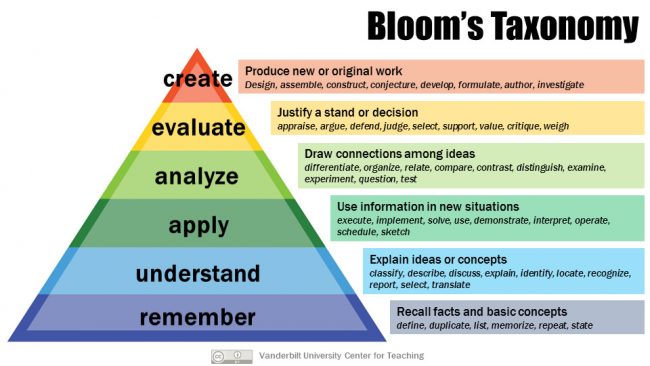
Customer service jobs require a composite mix of soft and hard skills for success. To positively interact with customers and team members we need social and emotional intelligence, and self-regulation skills. We also need lots of technical expertise, general industry and product knowledge to handle everyday customer requests effectively.
In our blog we have already published a series of articles highlighting skills for being awesome at customer service. Following those posts I would like to add up another skill crucial for service industry employees — critical thinking. This blog post also puts together some helpful techniques that foster this skill. I hope that these tips will help you grow personally and professionally, and let you progress to the next level along your career journey.
Critical Thinking and Bloom’s Taxonomy
Critical thinking is often referred to as an ability to think clearly and rationally about what to do or what to believe. It is also described as an ability to engage in reflective and independent thinking. Someone with critical thinking skills is able to draw reasonable conclusions from what they know, and also knows how to make use of information to solve problems.
The notion of critical thinking is closely related to the highest and most complex levels of Bloom’s Taxonomy, which represents the hierarchy of knowledge acquisition and application. The model implies that people gradually develop their thinking abilities and consistently learn to effectively apply the knowledge. The progress takes it from just remembering facts to understanding, applying, analyzing, evaluating and creating. In other words, the highest levels of the hierarchy comprise what we call “critical thinking”: the stage of actively and intelligently processing information to reach an answer or conclusion.

What is really breath-taking and important about critical thinking is that it can be developed in almost every human being through skill training. By contrast, Artificial Intelligence machines at present demonstrate less than half the learning abilities that humans have. That’s the conclusion of a recent research led by Jim Parker and Shannon Jaeger of University of Calgary. The aim of the research was to look into learning capabilities in AI and find out how Bloom’s Taxonomy applies to the field of machine learning. Although the researchers have seen that in some areas artificial intelligence outperforms their human counterparts in the lowest rungs of the taxonomy, they admit that machines can’t reach the top of it yet.
What Does This Mean for Customer Service?
Today, when AI and Robotics are not just buzzwords but also the key trends that shape future customer service jobs, and many routine tasks are delegated to smart machines, critical thinking becomes one of the most – if not the most – important skills for customer service representatives.
It’s no longer enough to learn scripts by rote and scrupulously follow standard procedures to become a good customer service professional. Today, customer service excellence is more about adopting a new mindset and moving away from manual routine tasks to more challenging and creative opportunities.
For instance, critical thinking skills can help customer service agents check against facts and detect a fraud or security issue. Human agents are also far better capable of delivering creative and empathetic customer service that matters so much in complex or controversial cases. And, of course, human agents have the unsurpassed ability to come up with out-of-the-box solutions, especially in high-stress moments for customers.
In the age of AI and automation, critical thinking becomes a highly sought-after career skill that will continue to be necessary into the future. So how do you go about developing critical thinking skills for customer service? Let me suggest a few techniques that I hope will come in handy.
Techniques for Improved Critical Thinking
1. 5 Why’s Root-Cause Analysis Technique
This is a simple but powerful technique intended to quickly uncover the main root cause of a problem and prevent it from happening again in the future.
This technique for exploring the cause-and-effect relationships underlying a particular problem was developed and widely used within the Toyota Motor Corporation. In a nutshell, the approach implies uncovering a problem source and nature by asking “why” no fewer than five times.
Here’s an illustrative example of 5 Why’s in action:

When it comes to critical thinking for customer service, the technique can be particularly useful. It’s important for service agents to get a habit of challenging themselves to go beyond merely resolving a single customer inquiry. Instead of closing the issue and leaving it behind, they can take an effort to delve deeper into questioning if the issue can cause a wider problem, how it can be fixed and if there’s anything to help prevent the problem in the future.
2. Survivorship Bias
While diagnosing a problem, it’s also important not to fall victim to wrong assumptions and recognize biases that often produce faulty thinking. The “survivorship bias” phenomenon is a good illustration for the power of critical thinking. And there’s a brilliant story behind it:
During World War II, the statistician Abraham Wald took survivorship bias into his calculations when considering how to minimize bomber losses to enemy fire. In fact, he worked out the secret to placing armor on aircraft bombers in a way that saved countless lives.
Researchers from the Center for Naval Analyses had conducted a study of the damage done to aircraft that had returned from missions, and had recommended that armor be added to the areas that showed the most damage. Wald noted that the study only considered the aircraft that had survived their missions—the bombers that had been shot down were not present for the damage assessment. The holes in the returning aircraft, then, represented areas where a bomber could take damage and still return home safely. Wald proposed that the Navy instead reinforce the areas where the returning aircraft were unscathed, since those were the areas that, if hit, would cause the plane to be lost.
Since then, it has become a common practice in data analysis to not only focus on the “survivors” data but also look out for absence of information. In customer service, this can be referred to unhappy customers who left without giving your company a chance to improve or change anything based on their feedback. Not only it teaches us to perceive customer service failures and successes more prudently, but also helps us see negative customer feedback from another perspective – as a valuable opportunity to gather the “right” data and improve.
3. Appreciative Inquiry (or 5 D’s)

This problem-solving approach was developed in 1987 by David Cooperrider and Suresh Srivastva of Case Western Reserve University. The principle suggests withdrawing from negative problem-focused and fear-based starting point. The main focus is on what’s valuable or good in current situation, and what can be done for positive change and moving forward. When you start defining the situation or topic from this new perspective, you discover some very different information about the issue, that brings along previously unseen, or unaknowledged strengths into the foreground.
The approach proceeds in 5 steps known as “5 D’s”: Define; Discover; Dream; Design; Deliver/Destiny. It takes a problem-solver from re-evaluating the situation and focusing on the bright side, to consequently finding out what might, should and will be possible to do in this particular situation. This model advocates collective inquiry and collaboration, followed by collective design of a desired outcome.
Practising this approach regularly to problem solving comes in very handy, too, as it lets you see a bigger picture and think of all possible solutions and improvements, rather than merely focus on an isolated issue taken by itself. Thus, it provides more tools and explores a wider range of options, and is based on the strong ‘can-do’ attitude, which is so important for positive problem resolution.
Over to You
Are there any other useful techniques or resources for developing critical thinking for customer service you would like to add? If you have another amazing story that inspires out-of-the-box problem-solving , you are welcome to share it with our blog readers in the comments below! And as always, thank you for reading our blog!
Provide Support is a leading software provider in customer service, offering live chat and real-time visitor monitoring tool for websites. Empowering customer service with live chat www.providesupport.com
- 4 Dimensions of Customer Trust: How To Get The Most of It - March 14, 2018
- The Importance of Critical Thinking in Customer Service - February 15, 2018
- Will AI Take Humans out of Customer Service in The Near Future? - January 10, 2018

This is great advice. Very honest and practical.I really enjoyed this post.Nice post. Thanks for sharing.
My pleasure, thanks for the comment
Excellent subject, to be honest I had never thought of this ability. Many thanks for the tips Julia.
Thank you Rony. Glad you’ve read the post and found it helpful
What an interesting discussion. I think, this is an advanced technique to understand more about customer service.
Great blog on useful discussion. This is really advanced helps to know more about Critical thinking in customer service. I can acquire more information about customer service throgh this blog. Thank you.
Indeed a condition that must be done critical thinking in customer service..
Critical thinking is I think the best problem-solving technique in customer service. Don’t think by making a nice chat, you can improve the satisfaction level of the consumers. Obviously not. Rather by resolving the problem timely, you can make your clients happy and keep them satisfied with your service. I know proper troubleshooting is nearly impossible to obtain. But if you have the ability to think critically, you can pay heed to the right details, and can solve the problems effectively crafting a win-lose situation instead.